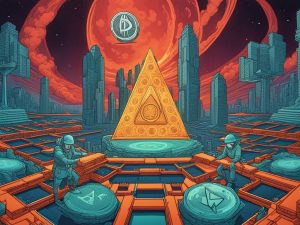Bitcoin: The Evolution of the Crypto Giant
Bitcoin has always been the cornerstone of the cryptocurrency space, but in the past, it had its limitations. Transactions were slow and expensive, and other chains offered more advanced features like smart contracts and faster, cheaper transactions. However, Bitcoin has undergone significant changes and now offers a wide range of options including Layer 2 solutions, DeFi, NFTs, DEXes, and games. In this article, we will explore some of the best decentralized applications (Dapps) that have found a home on Bitcoin.
1) DeFi on Bitcoin
Previously, users had to use wrapped Bitcoin (wBTC) on other chains to access DeFi. However, with the implementation of the Taproot upgrade in November 2021, Bitcoin now supports Dapps directly. Platforms like Stacks and Mintlayer have taken advantage of this upgrade to offer various DeFi options. Stacks is an independent chain with smart contracts and supports NFTs and micropayments through the Lightning Network. Mintlayer, on the other hand, is a Layer 2 solution that offers DeFi options and runs on the Lightning Network. It currently has an incentivized testnet until January 31st, 2024.
2) NFTs and Marketplaces on Bitcoin
The introduction of BTC NFTs (Bitcoin Ordinals) created a frenzy in the market. Numerous marketplaces emerged that allowed for the creation, minting, and trading of BTC NFTs. Gamma is one such marketplace built on Stacks that supports various types of NFTs including art, music, and BTC domain names. Centralized exchanges like Binance and OKX also offer BTC NFT marketplaces. Magic Eden is another well-known NFT marketplace that offers BTC Ordinals.
3) Bitcoin Wallets
With the rise of BTC NFTs, new Bitcoin wallets have emerged to accommodate the unique features of Ordinals. UniSat is an all-in-one wallet and marketplace for Ordinals and BRC-20 tokens. It does not require running a full node and also detects unconfirmed NFT transactions. XDEFI Wallet is a versatile wallet that connects to 34 different blockchains, including Bitcoin. Leather Wallet, formerly known as Hiro Wallet, is an OG wallet for Ordinals that allows users to create inscriptions and connect to various marketplaces.
4) Bitcoin Infrastructure
A robust infrastructure is essential for any blockchain ecosystem to function effectively. BitPay, a Bitcoin payment service established in 2011, caters to merchants. The Lightning Network, a layer 2 solution built on top of the Bitcoin chain, offers faster and cheaper transactions compared to the main network. The Taproot Assets Protocol operates off-chain to prevent congestion on the main network and is interoperable with the Lightning Network.
Hot Take: Bitcoin’s Transformation into a Multi-Faceted Powerhouse
Bitcoin has evolved significantly since its inception, overcoming its initial limitations to become a versatile platform. With the introduction of L2 solutions, DeFi capabilities, NFTs, specific wallets, and improved infrastructure, Bitcoin now offers a wide range of options for users. It has solidified its position as the most important pillar in the crypto space. As technology continues to advance, we can expect even more innovation and opportunities within the Bitcoin ecosystem.
Note: The information provided in this article is for educational and informational purposes only and should not be considered financial advice. Investing in cryptocurrencies carries risk, so it’s important to do your own research and exercise caution.
Source: X





 By
By
 By
By


 By
By
 By
By